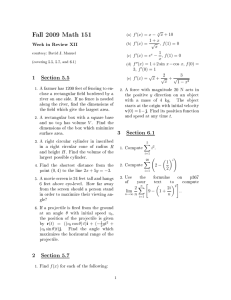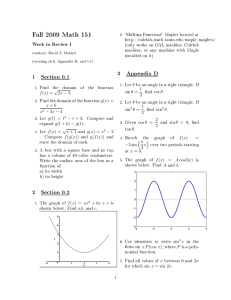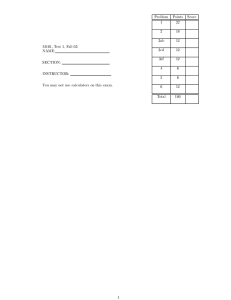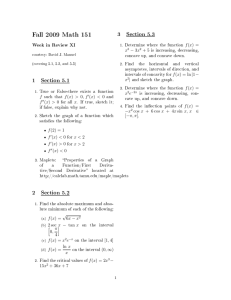Self Organising Maps for Value Estimation to Solve Reinforcement Learning Tasks
advertisement
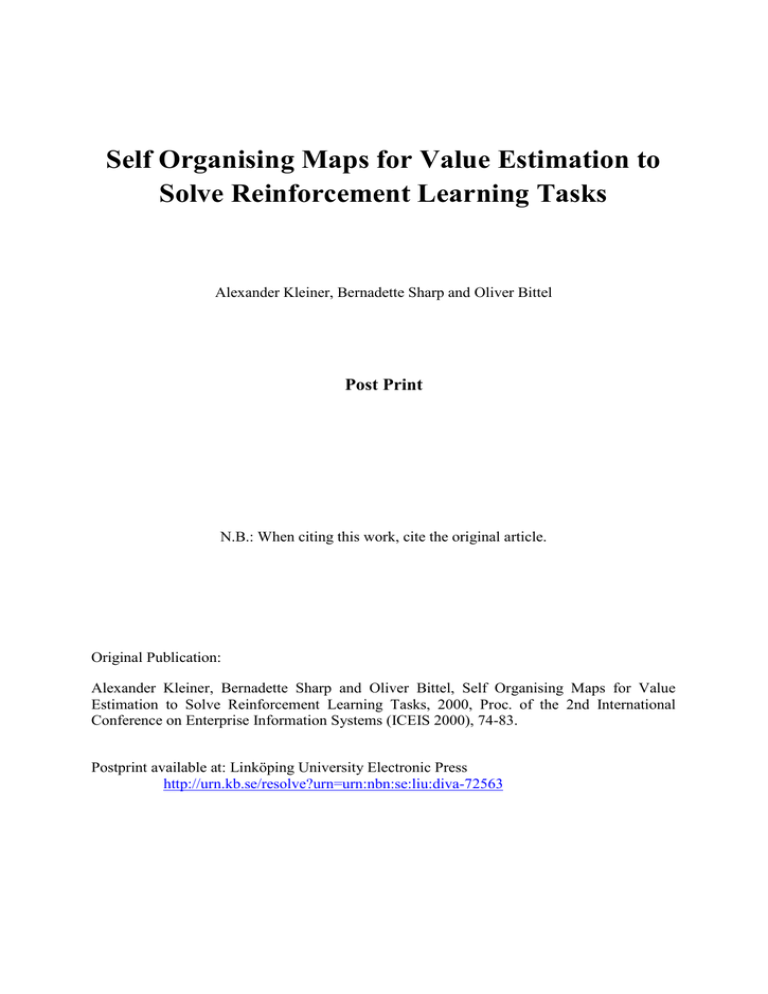
Self Organising Maps for Value Estimation to
Solve Reinforcement Learning Tasks
Alexander Kleiner, Bernadette Sharp and Oliver Bittel
Post Print
N.B.: When citing this work, cite the original article.
Original Publication:
Alexander Kleiner, Bernadette Sharp and Oliver Bittel, Self Organising Maps for Value
Estimation to Solve Reinforcement Learning Tasks, 2000, Proc. of the 2nd International
Conference on Enterprise Information Systems (ICEIS 2000), 74-83.
Postprint available at: Linköping University Electronic Press
http://urn.kb.se/resolve?urn=urn:nbn:se:liu:diva-72563
Self organising maps for value estimation to solve reinforement
learning tasks
A. Kleiner,B. Sharp, O. Bittel
Staordshire University
May 11, 2000
Abstrat
Reinforement learning has been applied reently more and more for the optimisation of
agent behaviours. This approah beame popular due to its adaptive and unsupervised learning
proess. One of the key ideas of this approah is to estimate the value of agent states. For
huge state spaes however, it is diÆult to implement this approah. As a result, various
models were proposed whih make use of funtion approximators, suh as neural networks,
to solve this problem. This paper fouses on an implementation of value estimation with a
partiular lass of neural networks, known as self organising maps. Experiments with an agent
moving in a \gridworld" and the autonomous robot Khepera have been arried out to show
the benet of our approah. The results learly show that the onventional approah, done by
an implementation of a look-up table to represent the value funtion, an be out performed in
terms of memory usage and onvergene speed.
Keywords: self organising maps, reinforement learning, neural networks
1
1
1
INTRODUCTION
1 Introdution
In this paper we disuss the redit assignment
problem, and the reinforement learning issue
assoiated with rewarding an agent upon suessful exeution of a set of ations. Figure 1 illustrates the interation between an agent and
its environment. For every ation, the agent
performs in any state st , it reeives an immediate reinforement rt and the perepts of the
suessor state st+1 . This immediate reinforement depends on the performed ation and on
the new state taken as well. For example, an
agent searhing for an exit in a maze might
be rewarded only if this exit is reahed. If
this state is found, it is obvious that all former states, whih ontributed to this suess,
have to be rewarded as well.
Reinforement learning is one solution for the
redit assignment problem. The idea of reinforement learning grew up within two dierent branhes. One branh foused on learning
by trial and error, whereas the other branh
foused on the problem of optimal ontrol. In
the late 1950s Rihard Bellman introdued his
approah of a value funtion or a \optimal return funtion" to solve the problem of optimal
ontrol (Bellman 1957). Methods to solve this
equation are nowadays known as dynami programming. This paper fouses on a generalization of these methods, known as temporal differene methods, whih has been introdued in
1988 by Rihard Sutton (Sutton 1988). These
methods assign, during an iterative proedure,
a redit to every state in the state spae, based
on a alulated dierene between these states.
Roughly speaking this implies, that if a future
state is desirable, the present state is as well.
Sutton introdued the parameter to dene,
how far in the future states have to be taken
into aount, thus this generalisation is named
T D (). Within this paper, however, the sim-
AGENT
state
st
reward
rt
Environment
Figure 1: The agent-environment interation
in reinforement learning
pler ase T D(0)1 is used, whih only onsiders
one suessor state during a temporal update.
Current methods for the \optimal return funtion" suer, however, under what Bellman
alled \the urse of dimensionality", sine
states from real world problems onsist usually
of many elements in their vetors. Therefore
it makes sense to use funtion approximators,
suh as neural networks, to learn the \optimal
return funtion".
Suessful appliations of reinforement learning with neural networks are testied by many
researhers. Barto and Crites (Barto & Crites
1996) desribe a neural reinforement learning approah for an elevator sheduling task.
Thrun (Thrun 1996) reports the suessful
learning of basi ontrol proedures of an autonomous robot. This robot learned with a
neural Q learning implementation, supported
by a neural network. Another suessful implementation was done by Tesauro at IBM
(Tesauro 1992). He ombined a feed-forward
network, trained by bakpropagation, with
T D () for the popular bakgammon game.
This arhiteture was able to nd strategies
using less induement and has even defeated
1
Also known as the value iteration method
action
at
2
2
SELF ORGANIZING MAPS (SOM)
hampions during an international ompeti- input spae, whih are supported by more samtion.
ples in the data, are represented more detailed
than areas supported with less samples.
Besides this suessful examples, whih are all
based on neural networks using bakpropaga- SOM arhiteture
tion, there is more and more evidene, that ar- A SOM usually onsists of a two dimensional
hitetures based on bakpropagation onverge grid of neurons. Every neuron is onneted
slowly or not at all. Examples for suh prob- via its weights to the input vetor, where one
lemati tasks are given by (Boyan & Moore weight is spent for every element of this ve1995) and (Gordon 1995). This diÆulties tor. Before the training proess, values of these
arise due to the fat that bakpropagation net- weights are set arbitrary. During the trainworks store information impliit. This means ing phase, however, the weights of eah neuron
for the training that every new update aets are modied to represent lusters of the input
former stored information as well. A onver- spae.
gene annot be guaranteed anymore, sine
the original approah of reinforement learning Mapping of pattern
is supposed to be used with an expliit look- After a network has been trained, a luster for
up table. Therefore our approah makes use an input vetor an be identied easily. To
of a neural network arhiteture with expliit nd the neuron, representing this luster, the
knowledge representation, known as self organ- Eulidean distane between this vetor and all
weight sets of the neurons on the SOM has to
ising maps.
be alulated. The neuron with the shortest
This paper will disuss the problems assoiated distane represents this vetor most preisely
with the use of self organising maps (SOMs) to and is thus named as \winner" neuron. The
learn the value funtion and desribe our modi- Eulidean distane is alulated after the foled approah to SOM applied to two problems. lowing equation:
n
di =
(wik xk )2 (1)
k=1
2 Self organizing maps (SOM)
Where wik denotes the i th neurons k th weight
Self organizing maps were rstly introdued and xk the k th element of the input vetor.
by Teuvo Kohonen in 1982 (Kohonen 1982).
These kind of neural networks are a typial Learning of lusters.
representative of unsupervised learning algo- The learning proess takes plae in a so alled
rithms. During the learning proess partiular oine learning. During a xed amount of repeneurons are trained to represent lusters of the titions, alled epohs, all patterns of the traininput data. The ahieved arrangement of these ing data are propagated through the network.
lusters is suh, that similar lusters, in terms At the beginning of the learning proess, valof their Eulidean distane, are near to eah ues of the weights are arbitrary. Therefore for
other and dierent lusters are far from eah every input vetor xi a neuron ui is hosen to
other. Hene, the network builds up a topol- be its representative by random as well. To
ogy depending on the data given to it from the manifest the struture of the map, weights are
input spae. This topology is equal to the sta- moved in diretion to their orresponding intistial distribution of the data. Areas of the put vetor. After a while the representation of
X
3
3
REINFORCEMENT LEARNING
input vetors beomes more stable, sine the input spae and train it over many epohs. AfEulidean distane of eah winner neuron de- ter the SOM is trained it is only possible to add
reases.
a new luster to the representation by repeating the learning proess with the old training
To build a topologial map, it is important to set and the new pattern.
adjust the weights of neighbours around the
neuron as well. Therefore a speial neighbourhood funtion has to be applied. This funtion 3 Reinforement Learning
should return to the winner neuron a value of
1 and to neurons with inreasing distane to it Classial approahes for neural networks tend
a dereasing value down to zero. Usually the to make use of spei knowledge about states
\sombrero hat funtion" or the Gaussian fun- and their orresponding output. This given
tion is used for that. By use of the Gaussian knowledge is used for a training set and after the training it is expeted to gain knowlfuntion, the neighbourhood funtion is:
edge about unknown situations by generalizajn ni j2
2
tion. However for many problems in the real
2
(2)
hi = e
world an appropriate training set an't be genWhere n denotes the winner neuron and ni erated, sine the \teaher" doesn't know the
any neuron on the Kohonen Layer. The stan- spei mapping. Nevertheless, it seems to be
dard deviation denotes the neighbourhood easy for the teaher to assess this mapping for
radius.
every state. When learning to drive a ar, for
example, one is not told how to operate the
For every input vetor the following update ar ontrols appropriately, the teaher, howrule will be applied to every neuron on the ever, bridges the gap in learning using approSOM:
priate feedbak, whih improves the learning
proess and leads nally to the desired map4wik = hi (xk wik ) (3)
ping between states and ations.
Where denotes the step size.
By this update rule, weights are updated in
disrete steps, dened by the step size . The
nearer neurons are to a hosen winner neuron, the more they are aeted by the update.
Thereby neighbouring neurons represent similar lusters, whih leads to a topologial map.
The advantage of SOMs is that they are able
to lassify samples of an input spae unsupervised. During the learning proess, the map
adapts its struture to the input data. Depending on the data, the SOM will build lusters and order them in an appropriate manner.
One disadvantage of SOMs is, however, the neessity to dene a representative subset of the
The Reinforement problem
The task of reinforement learning is to use rewards to train an agent to perform suessful
funtions. Figure 1 illustrates the typial interation between agent and environment. The
agent performs ations in its environment and
reeives a new state vetor, aused by this ation. Furthermore the agent gets feedbak of
whether the ation was adequate. This feedbak is expressed by immediate rewards, whih
also depend on the new state taken by the
agent. A hess playing agent, for example,
would reeive a maximum immediate reward
if it reahes a state where the opponent annot
move the king any more. This example illustrates very learly the redit assignment prob-
3
4
REINFORCEMENT LEARNING
lem. The reward ahieved in the last board
position is ahieved after a long hain of ations. Thus all ations, done in the past, are
responsible for the nal suess and therefore
also have to be rewarded. For this problem
several approahes have been proposed; a good
introdution to these is found in the book by
Barto and Sutton (Barto & Sutton 1998). This
paper, however, fouses on one of these approahes, whih is the value iteration method,
also known as T D(0).
lows:
Rewards 2
The diret goal for reinforement learning
methods is to maximise RT . To ahieve this
goal, however, a predition for the expetation
of rewards in the future is neessary. Therefore
we need a mapping from states to their orresponding maximum expetation. As known
from utility theory, this mapping is dened by
the value funtion 4 .
In reinforement learning, the only hints given
to the suessful task are immediate reinforement signals. These signals usually ome diretly from the environment or an be generated artiially by an assessment of the situation. If they are generated for a problem,
they should be hosen eonomially. Instead
of rewarding many sub-solutions of a problem,
only the main goal should be rewarded. For
example, for a hess player agent it would not
neessarily make sense to reward the taking of
the opponent's piees. The agent might nd
a strategy whih optimises the olletion of
piees of the opponent, but forgets about the
importane of the king. Reinforement learning aims to maximise the ahieved reinforement signals over a long period of time.
In some problems no terminal state an be
expeted, as in the ase of a robot driving
through a world of obstales and learning not
to ollide with them. An aumulation of rewards would lead to an innite sum. For the
ase where no terminal state is dened, we have
to make use of a disount fator to ensure that
the learning proess will onverge. This fator
disounts rewards whih might be expeted in
the future 3 , and thus an be omputed as fol2
Rewards also inlude negative values whih are
equal to punishments
3
These
expetations
are
based
on
knowledge
RT = rt+1 + rt+2 + 2 rt+3 + :::
=
XT k t k
r+
+1
(4)
k=0
Where RT denotes the rewards ahieved during
many steps, the disount fator and rt the
reward at time t. For T = 1 it has to be
ensured that < 1
The value funtion V (s)
In order to maximise rewards over time, it has
to be known for every state, what future rewards might be expeted. The optimal value
funtion V (s) provides this knowledge with a
value for every state. this return value is equal
to the aumulation of maximum rewards from
all suessor states. Generally this funtion
an be represented by a look-up table, where
for every state an entry is neessary. This funtion is usually unknown and has to be learned
by a reinforement learning algorithm. One
algorithm, whih updates this funtion suessive, is value iteration.
Value iteration
In ontrast to other available methods, this
method updates the value funtion after every seen state and thus is known as value iteration. This update an be imagined with an
ahieved in the past
4
In terms of the utility theory originally named util-
ity funtion
3
REINFORCEMENT LEARNING
agent performing ations and using reeived rewards, aused by this ations, to update values
of the former states. Sine the optimal value
funtion returns for every state the aumulation of future rewards, the update of a visited
state st has to inlude the value of the suessor state st+1 as well. Thus the value funtion
is learned after the following iterative equation:
Vk+1 (st ) := r (st ; at ) + Vk (st+1 ) (5)
5
gathered so far. This knowledge however an
lead to a loal optimal solution in the searh
spae, where global optimal solutions never an
be found. Therefore it makes sense to hose
ations, with a dened likelihood, arbritary.
The poliy to hose ation by a propability of "
arbritrary, is alled "-greedy poliy. Certainly
there is a trade-o between exploration and exploitation of existing knowledge and the optimal adjustment of this parameter depends on
the problem domain.
Where Vk+1 and Vk denote the value funtion before and after the update and r(st ; at )
Implementation of Value Iteration
refers to the immediate reinforement ahieved
So far, the algorithm an be summarised in the
for the transition from state st to state st+1
following steps:
by the hosen ation at . While applying this
method, the value funtion approximates more
and more until it reahes its optimum. That
selet the most promising ation at after
means that preditions of future rewards bethe "-greedy poliy
ome suessively more preise and ations an
be hosen with maximum future rewards.
at = arg mina2A(st ) (r (st ; a) + Vk (f (st ; a)))
There is an underlying assumption that the
apply at in the environment
agent's ations are hosen in an optimal manner. In value iteration, the optimal hoie of
st =) st+1
an ation an be done after the greedy-poliy.
This poliy is, simply after its name, to hose
adapt the value funtion for state st
ations whih lead to maximum rewards. For
an agent this means, to hose from all possiVk+1 (st ) := r (st ; at ) + Vk (st+1 )
ble ation a 2 A that one, whih returns after
equation (5) the maximum expetation. However we an see, that after equation (5) the
In theory, this algorithm will denitely evalsuessor state st+1 , aused by ation at , must
uate an optimal solution for problems, suh
be known. Thus a model of the environment
as dened at the beginning of this setion. A
is neessary, whih provides for state st and
problem to reinforement learning however, is
ation at the suessor state st+1 :
its appliation to real world situations. That
is beause real world situations are usually inst+1 = f (st ; at ) (6)
volved with huge state spaes. The value funtion should provide every state with an approExploration
priate value. But most real world problems
If all ations are hosen after the greedy-poliy, ome up with a multi-dimensional state vetor.
it might happen that the learning proess re- The state of a robot, for example, whose task is
sults in a sub-optimal solution. This is beause to nd a strategy to avoid obstales, an be deations are always hosen by use of knowledge sribed by the state of its approximity sensors.
4
6
MODIFIED SOM TO LEARN THE VALUE FUNCTION
If every sensor would have a possible return
value of 10 Bit and the robot itself owns eight
of these sensors, the state spae would onsist
of 1:2 1024 dierent states, emphasizing the
problem of tratability in inferening.
On the other hand, it might happen, that during a real experiment with a limited time, all
states an never be visited. Thus it is likely,
that even after a long training time, still unknown states are visited. But unfortunately
the value funtion an't provide a predition
for them.
is to get a generalisation for similar situations.
To ahieve this, the output weights have to be
trained with a neighbourhood funtion as well.
Therefore the output weights are adapted with
the following rule:
Æwi = 2 hi (y
wi ) (7)
Where 2 is a seond step size parameter and
hi the same neighbourhood funtion as used
for the input weights and y the desired output
of the network.
Modiation to the algorithm
As remarked previously, the learning algorithm
for SOMs is supposed to be applied \oine"
with a spei training set. The appliation of
value iteration however, is an \online" proess,
The two problems previously identied for re- where the knowledge inreases iteratively. To
inforement learning, an be solved using fun- solve this ontradition, the learning proess of
tion approximators. Neural Networks, in par- the SOM has been divided into two steps:
tiular, provide the benet of ompressing
the input spae and furthermore the learned
First step: pre-lassiation of the enviknowledge an be generalised. This means for
ronment
the value funtion, that similar states will be
evaluated by one neuron. Hene also unknown
Seond step: exeution of reinforement
states an be generalized and evaluated by the
learning with improvement of lassiapoliy. For this purpose the previously introtion for visited states
dued model of self organising maps has been
taken and modied.
For the rst step a representative sample of the
Modiation to the arhiteture
whole state spae is neessary, to build a approUsually SOMs are used for lassiation of in- priate map of the environment. This sample
put spaes, for whih no output vetor is ne- will be trained, until the struture of the SOM
essary. To make use of SOMs as funtion ap- is adequate to lassify states of the problems
proximator, it is neessary to extend the model state spae. During the exeution of the seby an output value. Suh modiations have ond step the reinforement learning algorithm
been rst introdued by Ritter and Shulten in updates states with their appropriate values.
onnetion with reex maps for omplex robot These states are lassied by SOMs, where one
movements (Ritter & Shulten 1987). The neuron is hosen as winner. The orrespondmodiation used here is, that every neuron of ing output weights of this neuron are hanged
the Kohonen layer is expanded by one weight, to the value, alulated by the reinforement
whih onnets it to the salar output. This learning algorithm. Furthermore, the output
output is used for the value funtion. The goal values of the neighbourhood of this neuron are
4 Modied SOM to learn the
value funtion
5
7
EXPERIMENTS AND RESULTS
modied as well to ahieve the eet of generalisation.
Usually the states, neessary to solve the problem, are a subset of the whole state spae.
Thus the SOM has to lassify only this subset, using a pre-lassiation. During the appliation of reinforement learning, this lassiation will improve, sine for every state visited, its representation is strengthen. States,
whih are visited more frequently and thus are
more important for the solution of the problem, will ahieve a better representation than
those unimportant states, whih are visited
less.
Figure 2: The gridworld experiment
Value Iteration Method
5 Experiments and results
The path-planning problem
This setion desribes the appliation of our
modied SOM with reinforement learning for
solving the path planning problem. The problem is to nd the shortest path through a maze
or simply a path on a map. For the experiment desribed here, a omputer simulation of
a \girdworld" has been taken (see Figure 2).
The gridworld is represented by a two dimensional arrangement of positions. Wall piee or
obstales an oupy these positions and the
agent therefore an't ross them. Other positions however, are free to its disovery. For
the experiment, the upper left orner is dened
as start position and the lower right orner
as end position. The agent's task is to nd
the shortest path between these two positions,
while avoiding obstales on its way.
Due to the fat, that the agent is supposed to
learn the \heapest" path, it is punished for
every move with -1 and rewarded with 0 if it
reahes the goal. Beside these reinforement
signals, the agent gets no other information,
about where it an nd the goal or whih di-
-200
SOM 10x10
Reinforcement
5.1
Convergence of different implementations
0
SOM 8x8
-400
Look-up table
-600
-800
-1000
0
50
100
Epochs
150
200
Figure 3: Ahieved rewards, during learning of
a behaviour for the gridworld experiment
retion should be preferred. If it faes an obstale, the possible ations are redued to that
ations, whih lead to free positions around.
Two implementations of a modied SOM with
8x8 neurons and 10x10 neurons have been
used. For omparison, the experiment has
been arried out with a look-up table, where
every entry represents a state, as well. This
look-up table onsists of 289 entries, due to
the used grid size is 17x17 positions.
5
8
EXPERIMENTS AND RESULTS
Results
The result of this experiment is shown in gure 3. In this graph the ahieved rewards for
eah implementation after every episode an
be seen. The optimal path is found, if the aumulated reinforement during one episode is
-53, sine the agent needs at least 53 steps to
reah its goal. In the graph an be seen, that
the implementation of the modied SOM with
10x10 neurons leads to a faster result than the
look-up table. After 30 episodes the agent,
equipped with the modied SOM, found the
heapest path.
5.2
Learning
obstale
avoidane
with a robot
A ommon problem in robotis is the autonomous drive of a robot. For suh a drive
there are various proesses. One proess might
bring it to a far destination, lead by a path
nding algorithm. For simple movement, however, a proess is neessary to avoid obstales.
In this problem, it is very diÆult to dene appropriate ations for partiular situations. On
the other hand, we an easily assess the resulting ations. Therefore this problem seems to
be appropriate for the reinforement learning
approah.
In this experiment the autonomous miniature
robot Khepera, whih was developed at the
EPFL in Lausanne, has been used (see gure
4). This 5 m huge robot is equipped with eight
approximity sensors, where two are mounted at
the front, two at the bak, two at the side and
two in 45Æ to the front. These sensors give a return value between 0 and 1024, whih is orresponding to a range of about 5 m. The robots
drive onsists of two servo motors, whih an
turn the two wheels with 2 m per seond in negative and positive diretions. By this onguration, the robot is able to do 360Æ rotations
without moving in x or y diretion. Therefore
Figure 4: Autonomous robot Khepera
the robot is very manoeuvrable and should be
able to deal with most situations. Furthermore
the robot is equipped with two rehargeable
batteries, whih enable it to drive for about 20
minutes autonomously. For exeution of programs, there also exists a CPU from Motorola
and a RAM area of 512KB on the robot.
Experiment
Due to the fat, that for value iteration a model
of the environment is required, the robot has
been rst trained using a omputer simulation.
Afterwards the experiment ontinued on a normal oÆe desk, where obstales and walls were
built up with wooden bloks.
In the reinforement learning algorithm, the
state of the robot was represented by the eight
sensor values. The allowed ations have been
redued to the three ations: left turn, right
turn and straight forward. Also the reinforement signals were hosen in the most trivial
way. If the robot ollides with an obstale, it
6
9
CONCLUSION
Learning to avoid obstacles
1
0
Reinforcement
0
10
20
30
40
Figure 5: A learned lassiation of the sensor
spae
gets a punishment of -1, otherwise a reward of
0. The experiment has been arried out over
multiple episodes. One episode has been limited to 50 steps. Therefore the disount fator
has been set to 1.0. For exploration purposes
the fator " has been adjusted to 0.01, whih
is equal to the probability ations are hosen
arbitrary. Conerning to the state vetor, the
input vetor of the SOM onsists of eight elements as well. For the Kohonen Layer an arrangement of 30x30 neurons has been hosen.
Before the appliation of the reinforement
learning algorithm, the SOM had to be prelassied. Therefore a training set of typial situations from an obstale world has been
trained over 90 epohs. With the help of visualisation tools it ould be ensured that the situations are adequately lassied, as illustrated
in gure 5.
During the episodes of the value iteration
method, identied situations were relearned
with a small neighbourhood of = 0:1 and
also small learning step rate of = 0:3.
50 0
20
60
40
80
100
Episode
Figure 6: Collisions during the autonomous
learning of an obstale avoidiane strategy
an be seen in gure 6. In this graph the aumulated rewards for every episode are shown.
Hene for every ollision the robot has been
punished with -1, the reinforement for every
episode is equal to the aused ollisions. After
45 episodes the number of ollisions beame
signiantly less. During the early episodes,
the value of ahieved reinforement signals
sways strongly. This results from the fat, that
after the robot overame a situation, it enountered a new situation again, where another behaviour had to be learned as well. As we see in
the graph, the robot learned to manage most
situations after a suÆient time of proeeding. After the training the learned ontrol has
been tested on the real robot. Although the
ahieved behaviour was not elegant, it proved,
that the robot obviously learned the ability to
avoid obstales.
6 Conlusion
The problem of a huge state spae in real
world appliations and the fat that mostly
The result of the learning proess of the robot some but unlikely all states of a state spae
Results
REFERENCES
an be enountered, have been takled by use
of a modied SOM. The SOMs abilities to
ompress the input spae and generalize from
known situations to unknown made it possible
to ahieve a reasonable solution. However, it
was neessary to split the standard algorithm
for SOMs into two parts. One learning by
a pre-lassiation and twie learning during
value iteration. With this modiation, the algorithm an be applied to an online learning
proess, whih is given by the value iteration
method.
The applied modiations to the standard
SOM have been evaluated within the gridworld
example and the problem of obstale avoidane
of an autonomous robot. These experiments
showed two main advantages of the modied
SOM to a standard implementation with a
look-up table. First, the example of obstale
avoidane proved that even for enormous state
spaes, a strategy an be learned. Seond, the
path nding example showed, that the use of a
modied SOM an lead to faster results, sine
the agent is able to generalize situations instead of learning a value for all of them.
10
SOM, proposed in this paper, yields better results.
One of the big disadvantages enountered however, is that the modiation of the SOM during the seond step hanges the generalisation behaviour of the network. If states are
relearned frequently with a small neighbourhood funtion, the learned knowledge beomes
too spei and generalisation is redued. To
overome this problem, it would be neessary
to relearn the omplete struture of the SOM
with an oine algorithm. Unfortunately, experiene in terms of training examples are lost after the online proess. A possible solution and
probably subjet of another work, is to store
\ritial" pattern temporarily during the online proess by dynami neurons. With \ritial" pattern we mean those, whih ome with
a far Eulidean distane to all existing neurons
in the network and thus their lassiation by
this neurons would not be appropriate. Given
the set of these dynamially alloated neurons
and the set of neurons on the SOM, a new arrangement with better topologial representation an be trained by an oine algorithm5.
The exeution of this oine algorithm an be
done during a phase of no input to the learner
and is motivated by a human post proessing
of information, known as REM phase.
For the Value Iteration algorithm, applied to
the experiments desribed here, a model of
the environment is neessary. For real world
problems, suh as the problem of obstale
avoidane, however, an appropriate model an
hardly be provided. Sensor signals are normally noisy or even it might be that a sensor Referenes
is damaged or don't work properly. Thus it is
reommendable to use another reinforement Barto, A. & Crites, R. (1996), Improving ellearning implementation, whih makes it not
evator performane using reinforement
any more neessary to provide a model of the
learning, in M. C. Hasselmo, M. C. Mozer
environment. One ommonly used variant of
& D. S. Touretzky, eds, `Advanes in
reinforement learning is the Q-Learning. In
Neural Information Proessing Systems',
this algorithm states are represented by the
Vol. 8.
tuple of state and ation, thus a model of the
5
environment is not required. We belief that a
For example the standard learning algorithm for
ombination of Q-Learning with the modied SOMs
11
REFERENCES
Barto, A. & Sutton, R. (1998),
Reinfoement
, MIT Press,
Learning - An Introdution
Cambridge.
Bellman, R. E. (1957), Dynami Programming,
Prineton University Press, Prineton.
Boyan, A. J. & Moore, A. W. (1995), Generalization in Renforemen Learning: Savely
Approximating the Value Funtion, in
T. K. Leen, G. Tesauro & D. S. Touretzky, eds, `Information Proessing Systems', Vol. 7, MIT Press, Cambridge MA.
Gordon, G. (1995), Stable funtion approximation in dynami programming, in `Proeedings of the 12th International Conferene on Mahine Learning', Morgan Kaufmann, San Fransiso, Calif., pp. 261{268.
Kohonen, T. (1982), Self-Organized Formation
of Topologially Corret Feature Maps, in
`Biol. Cybernetis', Vol. 43, pp. 59{69.
Ritter, H. & Shulten, K. (1987), Extending
Kohonen's Self-Organizing Mapping Algorithm to Learn Ballisti Movements, in
`Neural Computers', Springer Verlag Heidelberg, pp. 393{406.
Sutton, R. (1988), Learning to predit by the
methods of temporal dierenes, in `Mahine Learning', Vol. 3, pp. 9{44.
Tesauro, G. (1992), Pratial issues in temporal dierene learning, in `Mahine Learning', Vol. 8, pp. 257{277.
Thrun, S. (1996),
network
A
lifelong
learning
, Kluwer Aademi Publishers,
approah
Bosten.
Explanation-based neural
learning:
